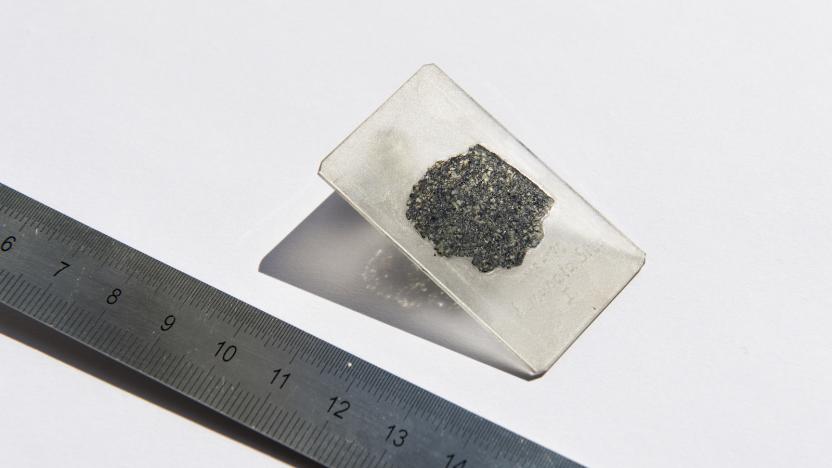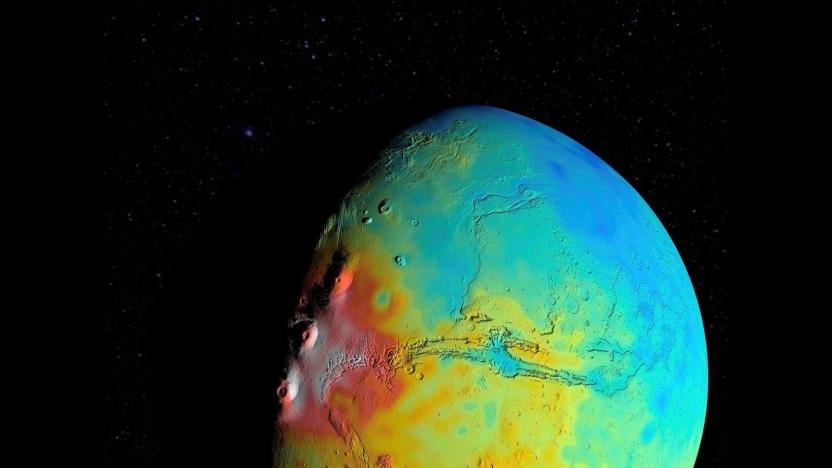TheMoon
Latest

Scientists think these meteorite diamonds formed on a long-lost planet
Scientists studying a meteorite fragment that fell to Earth in 2008 have found evidence that suggests it may have originated from a Mercury-sized planet that no longer exists. The makeup of a meteorite -- the elements it contains, what ratios they're in -- can usually point us to where it came from, like say the moon or Mars. But there are a set of meteorites, including the one collected in 2008, that have no known origin, appearing to be from a planetary body that has since been destroyed and purged from our solar system. "These samples are coming from an era that we don't have any access to," Farhang Nabiei, a researcher on the project, told The Washington Post.

Mars has a less dense crust than astronomers thought
Understanding the crust of a planet provides important information about the planet's history and its interior structure. But getting details about the crust of another planet -- like its thickness and density, for instance -- is no simple task. However, NASA researchers have developed a new way of analyzing the crusts of our solar system brethren that allows for more accurate estimates based on less information.

Moon Express details plans to mine the moon with robots by 2020
Spaceflight company Moon Express has released its plans to mine the moon with robots and it aims to get started by 2020. The company was founded in 2010 with the aim of winning the Google Lunar Xprize -- a competition to get privately funded spacecraft on the moon. And while it still has its sights on that prize, Moon Express has planned beyond that and has laid out a strategy for establishing its lunar outpost in just a few years.

The road to Mars: NASA's next 30 years
What will NASA be up to by 2030? The space agency (and even President Barack Obama) hopes it will be close to launching a manned mission to the surface of Mars. But, before that's possible, there's a whole lot of puzzle pieces to fit together. In fact, some of those pieces haven't even been invented yet. But NASA is already laying the groundwork. Dig through the agency's roadmap (a dense collection of science-heavy documents) and you can put together an outline of where its research and technology are headed. And, of course, the hope is that any invention or technological evolution will also find applications at home on Earth. Still, the focus remains on getting us to the red planet. Mars is certainly far, but it's going to seem much closer in a decade or two.

Did the moon spin off from another planet? German scientists say 'yes'
There are many wacky theories about how the moon was formed, including one that suggests it's actually a huge, dormant spacecraft. Of the several, slightly more scientific hypotheses, the leading one argues the moon was spun from the debris a collision between ancient Earth and a protoplanet scientists have named Theia. The "giant impact" theory, as it's known, has suffered from a lack of direct evidence, but now a group from a German university claim to have found some. Previous analyses of moon rock found it to be identical to rock on Earth, which disagrees with the theory as we should see chemical traces of the alien planet Theia. Armed with a more sophisticated mass spectrometer, a German team have re-examined moon rock and discovered a measurable difference in the ratio of Oxygen isotopes. In simpler terms, the samples have a slightly higher concentration of Oxygen 17 than Earth rock does, which the researchers claim is evidence that Theia played a part in the formation of the moon.

Alt-week 20.10.12: our oldest primate ancestor, the birth of the moon and a planet with four stars
Alt-week peels back the covers on some of the more curious sci-tech stories from the last seven days. Most mornings, we wake up with little to no idea what happened the day before, let alone last week. Fortunately, they don't let us run important scientific research projects. Or maybe they do, and we just forgot? This week (and most others as it goes) we definitely leave it to the pros, as we get some insightful glimpses at some important origins. Ball Lightning, the moon and even us humans are the benefactors of those tireless scientists, who work hard to explain where it all comes from. There's also a planet with four stars that sees the first few paragraphs of its origin story excitedly written out. One thing we never forget, however, is that this is alt-week.

Alt-week 10.6.12: supercomputers on the moon, hear the Earth sing and the future of sports commentary
Alt-week peels back the covers on some of the more curious sci-tech stories from the last seven days. Normally we try to encourage you to join us around the warm alt-week campfire by teasing you about what diverse and exotic internet nuggets we have for you inside. Sadly, this week that's not the case. There's nothing for you here we're afraid. Not unless you like totally mind-blowing space videos, singing planets and AI / sports commentary-flavored cocktails, that is. Oh, you do? Well what do you know! Come on in... this is alt-week.



